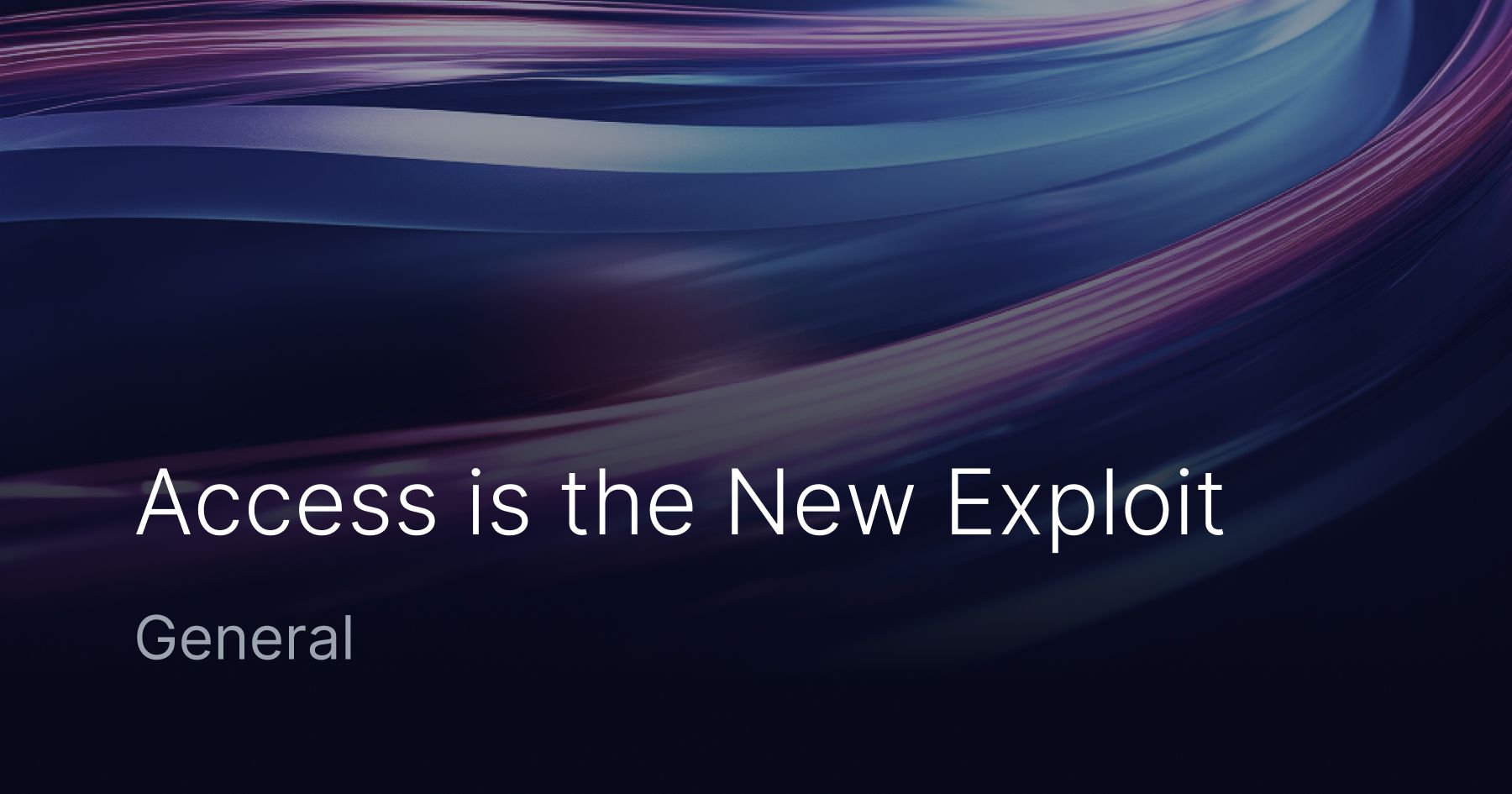Access Is the New Exploit

Access Is the New Exploit
When people think of a cyberattack, they often picture a hoodie-wearing hacker furiously typing lines of code to break through firewalls. But that image couldn’t be further from the truth.
The reality is that most modern data breaches don’t begin with a sophisticated technical exploit—they start with stolen login credentials. Whether through phishing, password reuse, session hijacking, or credential stuffing, today’s cybercriminals are far more likely to log in than hack in.
According to recent cybersecurity reports, over 60% of breaches involve credential abuse. Once attackers gain access, they move laterally across systems, escalate privileges, and exfiltrate data—often without triggering traditional perimeter defenses.
This shift represents a major security paradigm change: identity is now the primary attack surface. If your organization is still relying on outdated perimeter-based security or binary access controls, you’re leaving the door wide open for attackers with valid credentials.
Why Logging In Beats Hacking In
In today’s threat landscape, attackers no longer need to break in—they simply log in. With a valid set of credentials, cybercriminals can gain full access to your systems while flying under the radar of traditional security tools.
This shift marks a fundamental change in how breaches occur. Instead of exploiting vulnerabilities in software or infrastructure, attackers now leverage compromised identities to gain access. These credentials are often obtained through phishing emails, data breaches, dark web marketplaces, or insecure authentication mechanisms.
Once inside the environment, attackers behave like legitimate users. They:
- Move laterally across networks and systems,
- Escalate privileges by exploiting misconfigured roles or exposed secrets,
- Exfiltrate sensitive data without raising alarms.
This type of stealthy, identity-based attack bypasses many conventional detection tools that are focused on external threats or known malware signatures.
The real danger? It looks like a normal login.
That's why modern cybersecurity strategies must treat every login attempt as potentially malicious—verifying not just who is accessing a system, but also the context of the access.
The Real Attack Curve: How Breaches Actually Happen
Forget the flashy zero-days and complex malware campaigns. Most real-world breaches follow a predictable, repeatable pattern that begins with identity compromise and ends in complete system takeover. This is the modern attack curve—and understanding it is key to defending against it.
Here’s how attackers move through your infrastructure once they’ve logged in:
1. Initial Access: Phishing, Token Theft, or Purchased Credentials
Attackers start by obtaining valid credentials. This might involve:
- Phishing attacks to trick users into revealing login info,
- Stealing authentication tokens from browsers or endpoints,
- Buying usernames and passwords on dark web marketplaces.
This step gives them access without triggering alarms—because it looks like a normal user login.
2. Lateral Movement: Living Off the Land
Once inside, attackers move laterally across systems and environments using built-in tools like:
- PowerShell, SSH, and RDP,
- Kubernetes CLIs or AWS CLI,
- Internal dashboards or third-party services.
This “living off the land” approach minimizes detection by avoiding suspicious binaries or malware.
3. Privilege Escalation: Exploiting Roles and Secrets
Attackers then look for ways to escalate privileges by:
- Identifying misconfigured IAM roles or security groups,
- Accessing hard-coded secrets or SSH keys in scripts,
- Exploiting unpatched permission boundaries.
At this point, they often gain access to sensitive data or administrative functions.
4. Persistence: Staying Undetected
To maintain access, attackers establish persistence mechanisms like:
- Creating new accounts or roles,
- Deploying golden tickets in Active Directory environments,
- Hijacking long-lived sessions or refresh tokens.
This allows them to re-enter systems at will—even if initial access is discovered and revoked.
The attack isn’t a single event—it’s a series of quiet, strategic moves that rely on compromised identity and weak access controls. Defending against it requires visibility, control, and continuous verification at every step.
Identity: The Weak Link in Enterprise Security
In today’s security landscape, identity is not just a gateway—it’s the most exploited attack surface. While organizations invest heavily in perimeter defenses and endpoint protection, attackers are quietly bypassing them by targeting the weakest layer: human behavior.
Human Factors That Lead to Breaches
Cybercriminals don’t need to break your encryption or find a zero-day. More often, they simply exploit common mistakes, including:
- Weak passwords that are easy to guess or crack,
- Password reuse across multiple applications and environments,
- Hard-coded credentials embedded in code, scripts, or CI/CD pipelines.
These vulnerabilities allow attackers to gain valid access, making it almost impossible to distinguish between a real user and a malicious one.
Identity Sprawl: More Users, More Risk
As organizations grow and adopt more tools, platforms, and cloud services, identity sprawl becomes a serious security concern. Each user may have:
- Multiple unmanaged accounts,
- Access to legacy systems still in production,
- Inconsistent password and MFA policies.
This fragmentation results in poor visibility and control over who has access to what, increasing the risk of over-permissioned or orphaned accounts being abused.
Legacy Systems and Binary Trust Models
Many enterprise systems still operate on legacy trust models that assume anyone who logs in is trustworthy. This binary approach—authenticate once, access everything—no longer works in a world of remote work, cloud computing, and supply chain risk.
Legacy and static trust models typically lack:
- Granular, role-based access controls (RBAC),
- Support for just-in-time (JIT) access,
- Context-aware policies based on device, location, or behavior.
Attackers don’t need to breach your network—they just need to log in with valid credentials. And once they’re in, they exploit these identity flaws to move undetected.
Modern security demands more than just authentication. It requires dynamic, continuous verification—especially when identity is the first and most frequent target.
Credential-Based Breach Trends: The Data Behind the Danger
If you're still thinking of breaches as rare technical exploits, it’s time to look at the numbers. Credential-based attacks are not just common—they're now the dominant vector in cybersecurity incidents.
Recent industry reports make one thing clear: identity is the attack surface of choice for today’s threat actors.
📊 The Numbers Don’t Lie
- Two-thirds of breaches involve identity-based attacks, where threat actors use stolen or misused credentials to gain access without detection.
- According to the Verizon 2024 Data Breach Investigations Report (DBIR), 22% of all breaches begin with credential abuse.
- Over 60% of breaches involve the human element, such as phishing, social engineering, or credential misuse.
- In cloud environments, misconfigurations account for over 80% of incidents, often tied to over-privileged or mismanaged identities.
These trends aren’t isolated—they’re systemic. From cloud workloads to SaaS apps, attackers exploit the weakest links: exposed credentials, human error, and excessive access rights.
Identity-Centric Threats Are Growing
The rapid adoption of hybrid cloud infrastructure has only accelerated this trend. With more users, roles, and tokens distributed across platforms, managing identity and access has become exponentially more complex—and risky.
Threat actors are capitalizing on:
- Poorly enforced least-privilege principles,
- Lack of centralized visibility into access patterns,
- Overlooked third-party access and stale accounts.
The data paints a clear picture: breaches don’t start with firewalls failing—they start with credentials falling into the wrong hands. Preventing the next incident means focusing on identity security, continuous access monitoring, and eliminating unnecessary privilege.
Why Traditional Security Models Fail in the Modern World
For years, organizations have relied on a simple security model: authenticate the user once, then trust them indefinitely. But in today’s hybrid, multi-cloud environments, that binary “authenticate-and-trust” approach is dangerously outdated.
The Flaws of the Legacy Trust Model
Traditional access control assumes that once a user is authenticated—typically via a username and password—they can be trusted to act responsibly. This model might have worked in closed, on-prem environments, but it's fundamentally broken in today's:
- Remote-first workforce,
- API-driven infrastructures,
- Constantly shifting user and machine identities.
Once an attacker gains access using compromised credentials, binary trust models fail to challenge or verify their behavior. There’s no context check, no adaptive control, and no continuous validation. This allows threat actors to move freely and silently.
Legacy PAM Tools Can’t Keep Up
While Privileged Access Management (PAM) tools were designed to secure high-value systems, most legacy PAM solutions were not built for cloud-native architectures or modern DevOps workflows.
Common limitations include:
- Static credential vaulting, which doesn’t prevent lateral movement,
- Inability to support just-in-time (JIT) or ephemeral access,
- Limited integration with cloud platforms and ephemeral infrastructure like containers or serverless functions,
- Lack of real-time auditing or behavioral analysis.
Legacy tools often require manual configuration, can't scale across distributed environments, and offer poor user experiences—leading to workarounds and shadow access patterns.
Today’s threats require a new model—one that continuously verifies access based on identity, context, and behavior. Trust should be dynamic, least-privilege, and tightly scoped to specific actions—not something granted forever after a single login.
Enter Zero Trust Privileged Access: A New Security Standard
To stop modern identity-based attacks, organizations need more than stronger passwords or bigger firewalls—they need a complete shift in how trust is established and enforced. That shift begins with Zero Trust Privileged Access.
What Is Zero Trust?
Zero Trust is a security framework that assumes no user, device, or application should be trusted by default—even if they’re inside the network. Instead, trust must be:
- Continuously verified,
- Context-aware,
- Minimized to only what’s necessary (least privilege).
In other words, it’s not about who you are once—it’s about proving you belong, every time.
Core Principles of Zero Trust Privileged Access
To implement Zero Trust effectively—especially for privileged access—organizations must adopt these foundational principles:
🔐 Ongoing Identity and Context Verification
Authentication isn’t a one-time event. Every access request should be evaluated in real time based on:
- User identity and group membership,
- Device security posture,
- Location and time,
- Behavior anomalies or risk signals.
⏱️ Just-In-Time (JIT) Access
Rather than granting permanent access, users should be given temporary, task-specific access that automatically expires. This dramatically reduces the attack surface and enforces true least privilege.
✅ Secure Authentication Everywhere
Multi-Factor Authentication (MFA) must be non-negotiable across all systems, including:
- Internal servers,
- Third-party SaaS tools,
- DevOps infrastructure like databases and Kubernetes clusters.
No more exceptions, no more shared credentials.
📊 Comprehensive Logging and Auditing
All access—successful or failed—should be fully logged, monitored, and analyzed. This enables:
- Real-time anomaly detection,
- Compliance reporting,
- Post-incident forensics.
Without full visibility into who accessed what, when, and how—you’re operating blind.
Zero Trust Privileged Access isn’t just a best practice—it’s a necessity in today’s cloud-native, identity-centric threat landscape. It allows organizations to proactively reduce risk, contain breaches, and enforce security at every layer of access.
Zero Trust: Built-In by Design, Not Bolted On After
Too many organizations treat Zero Trust like a security plugin—something you add after the fact. But this mindset misses the point entirely. Zero Trust is not a feature to retrofit—it’s an architecture to build around.
Retrofitting Zero Trust Doesn’t Work
Trying to layer Zero Trust principles on top of legacy infrastructure leads to:
- Patchwork policies that are difficult to maintain,
- Inconsistent enforcement across cloud and on-prem environments,
- Limited visibility into real-time access activity,
- A fragile illusion of security that falls short when tested.
Legacy systems weren’t designed with dynamic, identity-driven access in mind. As a result, bolt-on Zero Trust tools often leave critical gaps in enforcement and monitoring.
Build Zero Trust Into the Foundation
To truly benefit from Zero Trust, organizations must design it into the core of their infrastructure. That means:
- Treating every access request—human or machine—as untrusted by default,
- Continuously validating identity, device, and context before granting access,
- Applying granular, least-privilege controls across all assets and services.
This architectural approach ensures that Zero Trust principles scale with your environment and adapt to modern cloud-native operations.
Trust Nothing, Verify Everything
The foundational principle of Zero Trust is simple:
Trust nothing. Verify everything.
That includes users, workloads, APIs, and third-party tools—regardless of location or network.
When Zero Trust is baked in—not bolted on, it becomes a powerful strategy to prevent lateral movement, reduce risk, and enforce consistent access control everywhere.
Zero Trust isn’t a quick fix—it’s a long-term security investment rooted in architecture. Organizations that treat it as such will be far better equipped to defend against credential-based and identity-driven attacks.
Conclusion: Breaches Start with Logins—It’s Time to Rethink Trust
In a world where cybercriminals log in more than they hack in, it’s clear that traditional security models no longer hold up. Today’s most damaging breaches don’t begin with a firewall failure—they begin with a stolen credential and a silent login.
The modern enterprise threat landscape demands a new approach—one that treats identity as the first and most critical control point.
That’s why Zero Trust Privileged Access is no longer optional. To stay ahead of identity-based threats, organizations must move beyond outdated perimeter models and adopt a continuous, contextual, and least-privilege approach to access.
🔐 Make the Shift with Adaptive
At Adaptive, we make it easy to:
- Eliminate standing credentials and over-permissioned access,
- Grant just-in-time, role-based access across cloud and on-prem systems,
- Continuously verify identity and session context before granting access,
- Gain full visibility into every privileged action with real-time auditing.
Whether you're securing critical infrastructure, developer access, or third-party vendors—Adaptive helps you enforce Zero Trust from the ground up.
✅ Ready to protect access where it matters most?
Schedule a demo to see how Adaptive.Live can help you stop breaches at the login.
 SOC2 Type II
SOC2 Type II

